Wilms' tumor medical therapy: Difference between revisions
(Created page with "__NOTOC__ {{Wilms' tumor}} Please help WikiDoc by adding content here. It's easy! Click here to learn about editing. ==References== {{reflist|2}} ...") |
Sargun Walia (talk | contribs) |
||
| (43 intermediate revisions by 5 users not shown) | |||
| Line 1: | Line 1: | ||
__NOTOC__ | __NOTOC__ | ||
{{Wilms' tumor}} | {{Wilms' tumor}} | ||
{{CMG}}; {{AE}} {{SSW}}{{SC}} | |||
==Overview== | |||
The mainstay of treatment of wilms tumor is [[nephrectomy]]. This is followed by chemotherapy with/without [[chemotherapy]]. Chemotherapeutic agent used is chosen based on the [[histology]] and stage of the tumor. The duration and dose of the chemotherapy varies depending on the stage and age of the patient .There are two schools of thought as to the best therapy for Wilms' tumor. The National Wilms' Tumor Study (NWTS) and The International Society of Paediatric Oncology(SIOP). Preoperative chemotherapy before [[nephrectomy]] is indicated in the situations like synchronous bilateral wilms tumor, wilms tumor in a solitary kidney, inoperable tumor. and pulmonary compromise. | |||
==Medical therapy== | |||
* The mainstay of treatment of wilms tumor is [[nephrectomy]]. | |||
* This is followed by chemotherapy with/without chemotherapy. | |||
* Chemotherapeutic agent used is chosen based on the histology and stage of the tumor. | |||
* Chemotherapeutic agents used are:<ref name="pmid3589819">{{cite journal |vauthors=Bradford DS, Schumacher WL, Lonstein JE, Winter RB |title=Ankylosing spondylitis: experience in surgical management of 21 patients |journal=Spine |volume=12 |issue=3 |pages=238–43 |date=April 1987 |pmid=3589819 |doi= |url=}}</ref> | |||
** [[Dactinomycin]] | |||
** [[Vincristine sulfate|Vincristine]] | |||
** [[Doxorubicin hydrochloride|Doxorubicin]] | |||
** [[Cyclophosphamide]] | |||
** Etoposide | |||
** [[Carboplatin]] | |||
* The duration and dose of the chemotherapy varies depending on the stage and age of the patient . | |||
'''Chemotherapy of patient with favourable histology (FH) post nephrectomy:''' | |||
{| class="wikitable" | |||
!Stage & Histology | |||
!Chemotherapy | |||
!Radiation therapy | |||
|- | |||
|Stage 1 or 2 | |||
without loss of heterozygosity | |||
|[[Vincristine sulfate|Vincristine]] | |||
[[Dactinomycin]] | |||
|Not required | |||
|- | |||
|Stage 1 or 2 | |||
with LOH 1p and 16q | |||
|[[Vincristine sulfate|Vincristine]] | |||
[[Dactinomycin]] | |||
[[Doxorubicin hydrochloride|Doxorubicin]] | |||
|Not requireed | |||
|- | |||
|Stage 3 and 4 | |||
without LOH 1p and 16q | |||
|[[Vincristine sulfate|Vincristine]] | |||
[[Dactinomycin]] | |||
[[Doxorubicin hydrochloride|Doxorubicin]] | |||
|Required | |||
|- | |||
|Stage 3 and 4 | |||
with LOH 1p and 16q | |||
|[[Vincristine sulfate|Vincristine]] | |||
[[Dactinomycin]] | |||
[[Doxorubicin hydrochloride|Doxorubicin]] | |||
[[Cyclophosphamide]] | |||
Etoposide | |||
|Required | |||
|} | |||
This summary focuses on the NWTS (now COG Renal Tumor Committee) results and studies. | |||
The major treatment and study conclusions of NWTS-1 through NWTS-5 (NWTS-1, NWTS-2, NWTS-3, NWTS-4, and NWTS-5) are as follows:<ref name="pmid32528">{{cite journal |vauthors=Veylon R |title=[Man and the environment. 6th congress of the International Society for Research on Diseases of Civilization and the Environment, Brussels, 6-9 September 1978] |language=French |journal=Nouv Presse Med |volume=7 |issue=41 |pages=3788, 3791 |date=November 1978 |pmid=32528 |doi= |url=}}</ref> | |||
* The prognosis for patients with stage III favourable histology(FH) is best when treatment includes either: | |||
** Dactinomycin + vincristine + doxorubicin with 10.8 Gy of radiation therapy to the flank. | |||
** Dactinomycin + vincristine with20 Gy of radiation therapy to the flank. | |||
** Whole abdominal radiation is indicated for extensive intraperitoneal disease or widespread intraperitoneal tumor spill. | |||
* The addition of cyclophosphamide at the protocol dose (10 mg/kg/d for 3 days every 6 weeks) to the combination of vincristine, dactinomycin, and doxorubicin does not improve prognosis for patients with stage IV FH tumors. | |||
* A single dose of dactinomycin per course (stages I–II FH, stage I anaplastic, stage III FH, stages III–IV, or stages I–IV clear cell sarcoma of the kidney) is equivalent to the divided-dose courses, results in the same EFS, achieves greater dose intensity, and is associated with less toxicity and expense. | |||
* Eighteen weeks of therapy is adequate for patients with stage I and II FH, whereas other patients can be treated with 6 months of therapy instead of 15 months. | |||
* Tumor-specific loss of heterozygosity for combined 1p and 16q predicts recurrence of FH Wilms tumor. | |||
There are two schools of thought as to the best therapy for Wilms' tumor. | |||
* The '''National Wilms' Tumor Study (NWTS)''' | |||
** It has been studying this tumor in the United States since 1969.<ref name="pmid2809467">{{cite journal |vauthors=Fujita H |title=Freeze-fracture method and its application to the cell biology |journal=J Electron Microsc (Tokyo) |volume=38 Suppl |issue= |pages=S110–7 |date=1989 |pmid=2809467 |doi= |url=}}</ref> | |||
** This group recommends surgery as the primary therapy for Wilms' tumor. | |||
** They have carried out extensive research on this tumor which has been used to guide therapy, as well as to classify tumors into high and low risk groups based on molecular features and to estimate prognosis. <ref>http://www.nwtsg.org/about/about.html</ref> | |||
* The '''International Society of Paediatric Oncology(SIOP)''' | |||
** It is followed in Europe. | |||
** It recommends preoperative chemotherapy to downstage the tumor prior to surgery to reduce the risk of intraoperative rupture of the tumor and dissemination of the malignant cells. | |||
** A 4 week period of preoperative chemotherapy decreases the risk of intraoperative rupture of the tumor. | |||
'''Preoperative chemotherapy before nephrectomy is indicated in the following situations:'''<ref name="cancergov">National Cancer Institute. Physician Data Query Database 2015. http://www.cancer.gov/publications/pdq </ref> | |||
* Synchronous bilateral Wilms tumor. | |||
* Wilms tumor in a solitary kidney. | |||
* Extension of tumor [[thrombus]] in the [[inferior vena cava]] above the level of the [[Hepatic vein|hepatic veins]]. | |||
* Tumor involves contiguous structures whereby the only means of removing the kidney tumor requires removal of the other structures (e.g., [[spleen]], [[pancreas]], or [[Colon (anatomy)|colon]] but excluding the [[adrenal gland]]). | |||
* Inoperable Wilms tumor. | |||
*Pulmonary compromise due to extensive [[Pulmonary metastasis|pulmonary metastases]]. | |||
[[File:Wilm1.png|thumb|none|400px|This image is provided by the National Library of Medicine.]] | |||
[[File:Wilm2.png|thumb|none|400px|This image is provided by the National Library of Medicine.]] | |||
[[File:Wilm3.png|thumb|none|400px|This image is provided by the National Library of Medicine.]] | |||
[[File:Wilm4.png|thumb|none|400px|This image is provided by the National Library of Medicine.]] | |||
[[File:Wilm5.png|thumb|none|400px|This image is provided by the National Library of Medicine.]] | |||
'''Treatment options for stage V and those predisposed to developing bilateral Wilms tumor''' | |||
* Currently, there is not a standard approach for the treatment of stage V Wilms tumor (bilateral Wilms tumor at diagnosis) and those predisposed to developing Wilms tumor. | |||
* Management of a child with bilateral Wilms tumor is very challenging. The goals of therapy are to eradicate all tumor and to preserve as much normal renal tissue as possible, with the hope of decreasing the risk of chronic renal failure among these children. | |||
==References== | ==References== | ||
{{reflist|2}} | {{reflist|2}} | ||
{{WH}} | {{WH}} | ||
{{WS}} | {{WS}} | ||
[[Category:Kidney diseases]] | [[Category:Kidney diseases]] | ||
[[Category:Types of cancer]] | [[Category:Types of cancer]] | ||
[[Category:Urology]] | [[Category:Urology]] | ||
[[Category:Pediatrics]] | [[Category:Pediatrics]] | ||
[[Category:Hematology]] | [[Category:Hematology]] | ||
Latest revision as of 21:06, 11 June 2018
|
Wilms' tumor Microchapters |
|
Diagnosis |
|---|
|
Treatment |
|
Case Studies |
|
Wilms' tumor medical therapy On the Web |
|
American Roentgen Ray Society Images of Wilms' tumor medical therapy |
|
Risk calculators and risk factors for Wilms' tumor medical therapy |
Editor-In-Chief: C. Michael Gibson, M.S., M.D. [1]; Associate Editor(s)-in-Chief: Sargun Singh Walia M.B.B.S.[2]Shanshan Cen, M.D. [3]
Overview
The mainstay of treatment of wilms tumor is nephrectomy. This is followed by chemotherapy with/without chemotherapy. Chemotherapeutic agent used is chosen based on the histology and stage of the tumor. The duration and dose of the chemotherapy varies depending on the stage and age of the patient .There are two schools of thought as to the best therapy for Wilms' tumor. The National Wilms' Tumor Study (NWTS) and The International Society of Paediatric Oncology(SIOP). Preoperative chemotherapy before nephrectomy is indicated in the situations like synchronous bilateral wilms tumor, wilms tumor in a solitary kidney, inoperable tumor. and pulmonary compromise.
Medical therapy
- The mainstay of treatment of wilms tumor is nephrectomy.
- This is followed by chemotherapy with/without chemotherapy.
- Chemotherapeutic agent used is chosen based on the histology and stage of the tumor.
- Chemotherapeutic agents used are:[1]
- The duration and dose of the chemotherapy varies depending on the stage and age of the patient .
Chemotherapy of patient with favourable histology (FH) post nephrectomy:
| Stage & Histology | Chemotherapy | Radiation therapy |
|---|---|---|
| Stage 1 or 2
without loss of heterozygosity |
Vincristine | Not required |
| Stage 1 or 2
with LOH 1p and 16q |
Vincristine | Not requireed |
| Stage 3 and 4
without LOH 1p and 16q |
Vincristine | Required |
| Stage 3 and 4
with LOH 1p and 16q |
Vincristine
Etoposide |
Required |
This summary focuses on the NWTS (now COG Renal Tumor Committee) results and studies.
The major treatment and study conclusions of NWTS-1 through NWTS-5 (NWTS-1, NWTS-2, NWTS-3, NWTS-4, and NWTS-5) are as follows:[2]
- The prognosis for patients with stage III favourable histology(FH) is best when treatment includes either:
- Dactinomycin + vincristine + doxorubicin with 10.8 Gy of radiation therapy to the flank.
- Dactinomycin + vincristine with20 Gy of radiation therapy to the flank.
- Whole abdominal radiation is indicated for extensive intraperitoneal disease or widespread intraperitoneal tumor spill.
- The addition of cyclophosphamide at the protocol dose (10 mg/kg/d for 3 days every 6 weeks) to the combination of vincristine, dactinomycin, and doxorubicin does not improve prognosis for patients with stage IV FH tumors.
- A single dose of dactinomycin per course (stages I–II FH, stage I anaplastic, stage III FH, stages III–IV, or stages I–IV clear cell sarcoma of the kidney) is equivalent to the divided-dose courses, results in the same EFS, achieves greater dose intensity, and is associated with less toxicity and expense.
- Eighteen weeks of therapy is adequate for patients with stage I and II FH, whereas other patients can be treated with 6 months of therapy instead of 15 months.
- Tumor-specific loss of heterozygosity for combined 1p and 16q predicts recurrence of FH Wilms tumor.
There are two schools of thought as to the best therapy for Wilms' tumor.
- The National Wilms' Tumor Study (NWTS)
- It has been studying this tumor in the United States since 1969.[3]
- This group recommends surgery as the primary therapy for Wilms' tumor.
- They have carried out extensive research on this tumor which has been used to guide therapy, as well as to classify tumors into high and low risk groups based on molecular features and to estimate prognosis. [4]
- The International Society of Paediatric Oncology(SIOP)
- It is followed in Europe.
- It recommends preoperative chemotherapy to downstage the tumor prior to surgery to reduce the risk of intraoperative rupture of the tumor and dissemination of the malignant cells.
- A 4 week period of preoperative chemotherapy decreases the risk of intraoperative rupture of the tumor.
Preoperative chemotherapy before nephrectomy is indicated in the following situations:[5]
- Synchronous bilateral Wilms tumor.
- Wilms tumor in a solitary kidney.
- Extension of tumor thrombus in the inferior vena cava above the level of the hepatic veins.
- Tumor involves contiguous structures whereby the only means of removing the kidney tumor requires removal of the other structures (e.g., spleen, pancreas, or colon but excluding the adrenal gland).
- Inoperable Wilms tumor.
- Pulmonary compromise due to extensive pulmonary metastases.
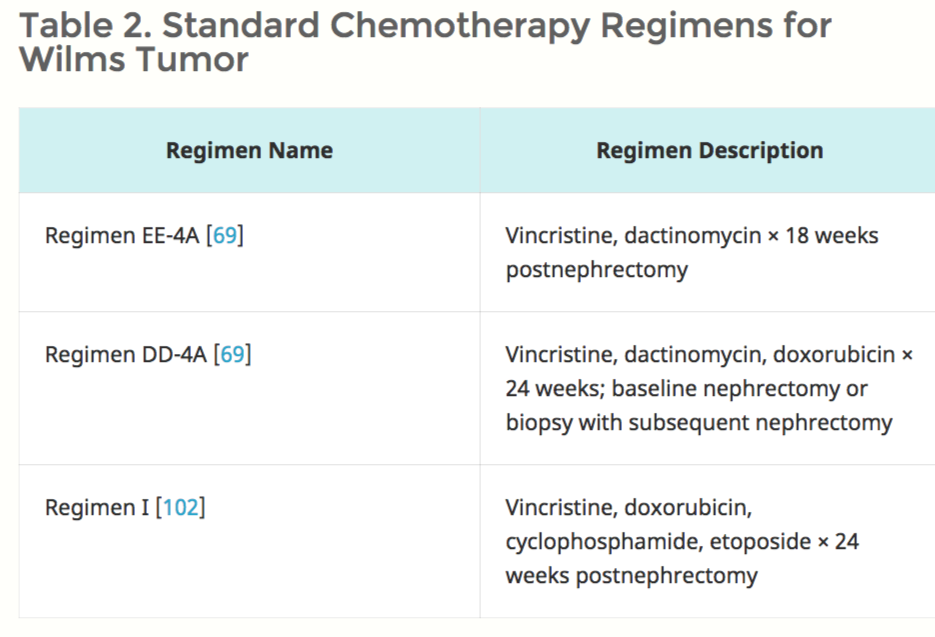
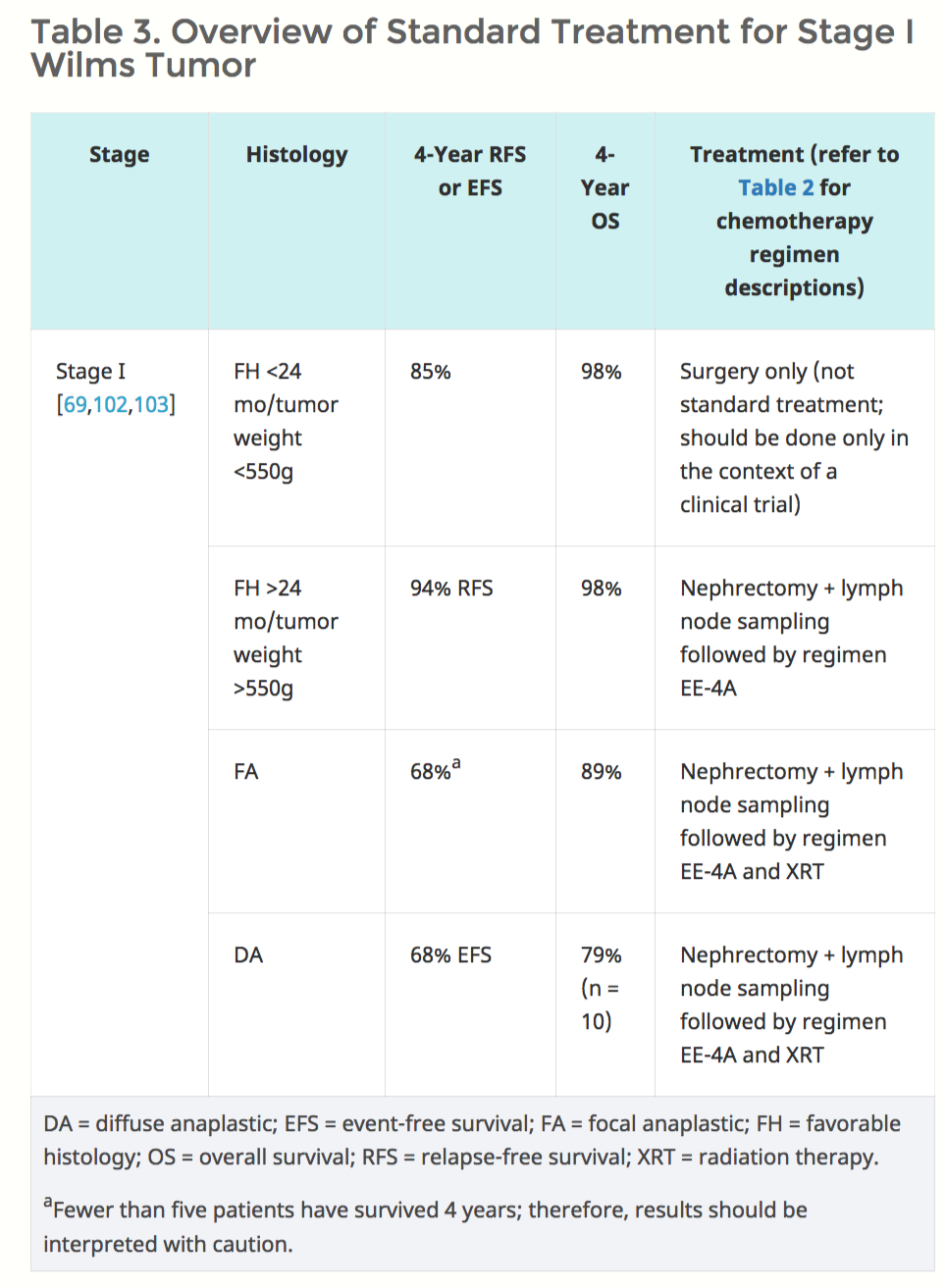
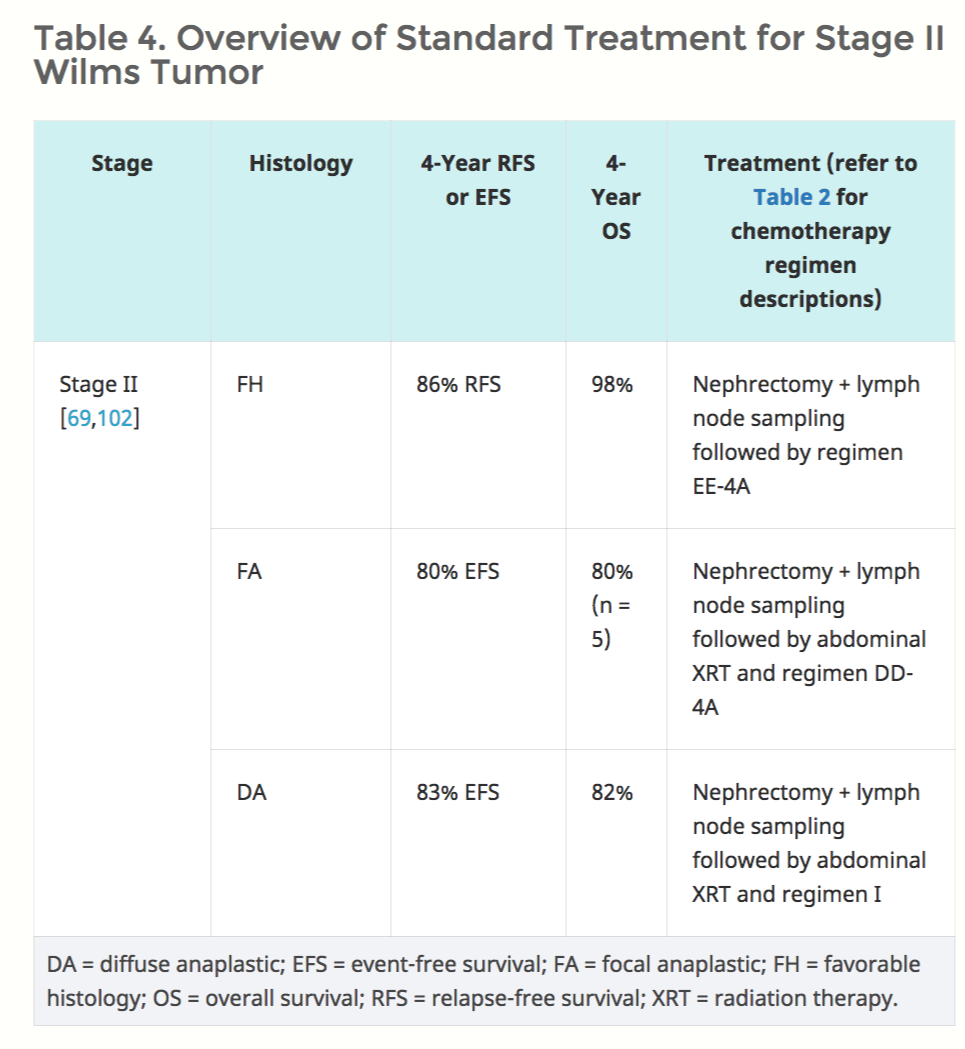
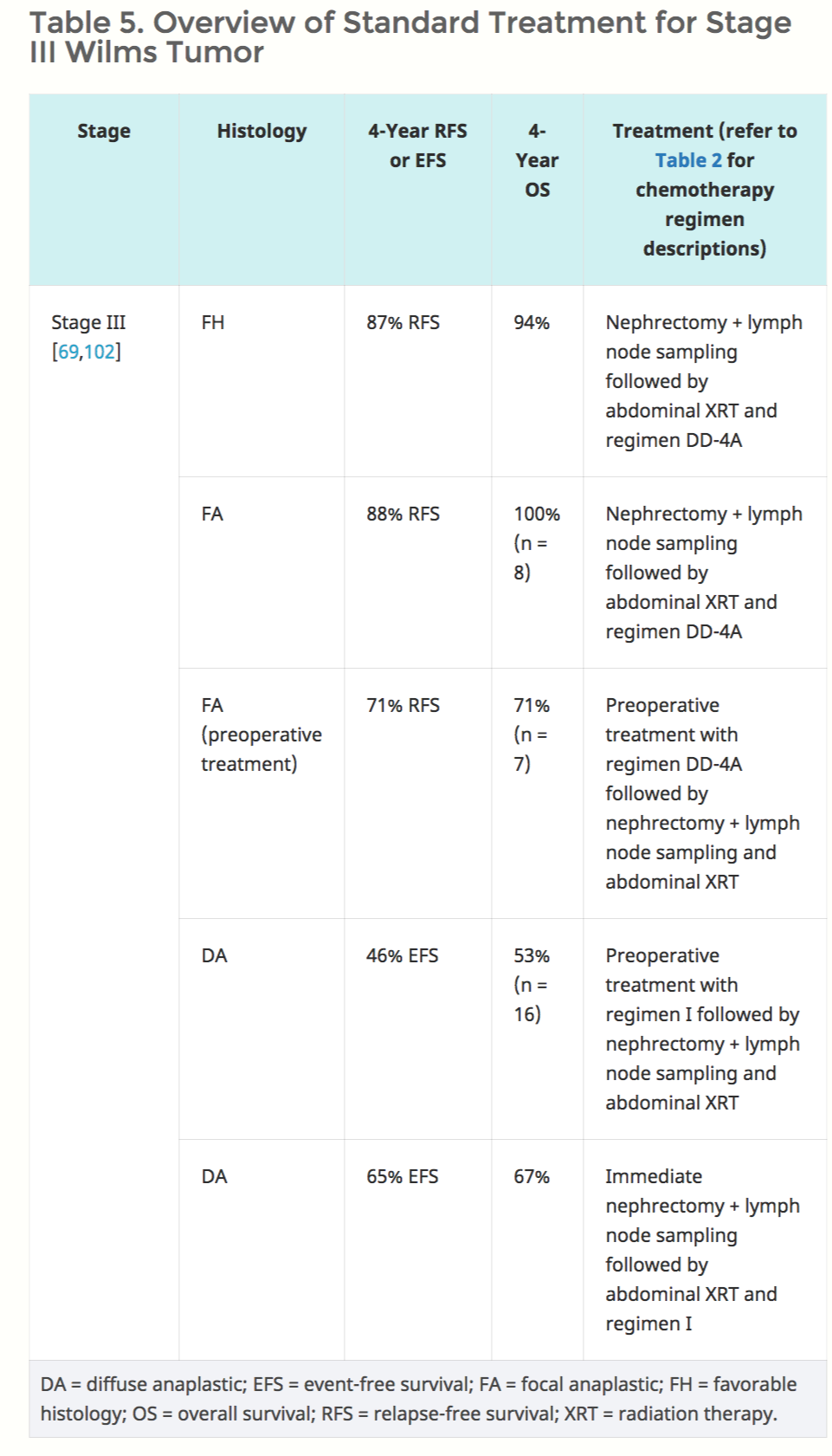
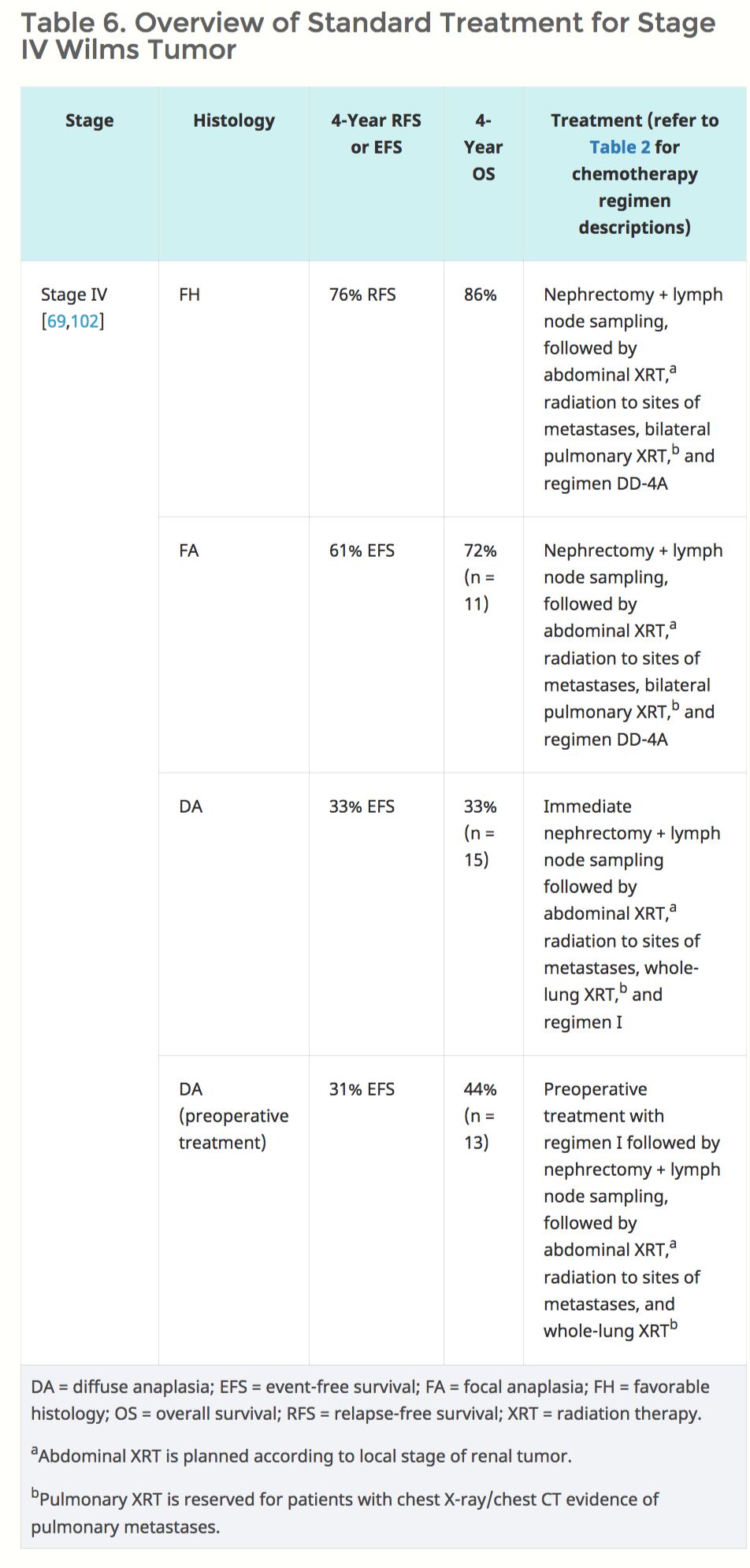
Treatment options for stage V and those predisposed to developing bilateral Wilms tumor
- Currently, there is not a standard approach for the treatment of stage V Wilms tumor (bilateral Wilms tumor at diagnosis) and those predisposed to developing Wilms tumor.
- Management of a child with bilateral Wilms tumor is very challenging. The goals of therapy are to eradicate all tumor and to preserve as much normal renal tissue as possible, with the hope of decreasing the risk of chronic renal failure among these children.
References
- ↑ Bradford DS, Schumacher WL, Lonstein JE, Winter RB (April 1987). "Ankylosing spondylitis: experience in surgical management of 21 patients". Spine. 12 (3): 238–43. PMID 3589819.
- ↑ Veylon R (November 1978). "[Man and the environment. 6th congress of the International Society for Research on Diseases of Civilization and the Environment, Brussels, 6-9 September 1978]". Nouv Presse Med (in French). 7 (41): 3788, 3791. PMID 32528.
- ↑ Fujita H (1989). "Freeze-fracture method and its application to the cell biology". J Electron Microsc (Tokyo). 38 Suppl: S110–7. PMID 2809467.
- ↑ http://www.nwtsg.org/about/about.html
- ↑ National Cancer Institute. Physician Data Query Database 2015. http://www.cancer.gov/publications/pdq